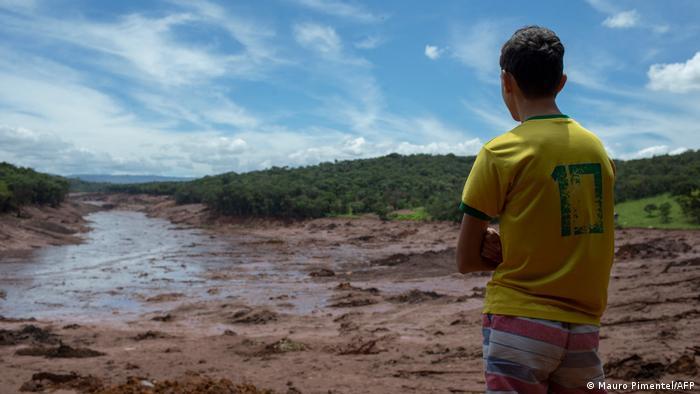Brazil Dams: 1 Million Live Close to Danger

A boy looks at the mud that reached the city of Brumadinho, in Brazil, after a dam at an iron-ore mine collapsed in January 2019. Hundreds were killed in the disaster.
Around 1 million people in Brazil live near a dangerous dam, according to a DW analysis. The situation raises alarm bells about the possible consequences of yet another accident in the country, which has seen three large-scale dam disasters since 2009.
The finding includes all those living in populated areas no more than a kilometer away from one of the 1220 dams that combine "high risk" and "high potential damage" classifications in Brazil's National Dam Safety Information System (SNISB).
A high-risk classification means that a dam has structural damage, design flaws or is not properly maintained, putting it at greater risk of organizational mishaps and safety incidents that could lead to a rupture. A high potential damage classification, in turn, means that such a failure would have major environmental, human or economic costs.

The issue is being exacerbated by flawed governance. Despite legal requirements, many dams don't have safety and emergency plans that outline what should be done in the event of a disaster.
According to SNISB data collected in February 2022, 39 of the dams classified as "high risk" and "high potential damage" hold mining waste, which is considered particularly unstable. The recent disasters in the cities of Mariana in 2015 and Brumadinho in 2019 involved such dams.
Most of the risky structures, however, are water storage and irrigation dams. They're mainly located in the Northeast, a comparatively poor region that historically has suffered from water shortages.
Many of the reservoirs in the area were built to offset drought. Without proper maintenance, they pose a danger to around 600,000 people in that region alone.
Dams — a sign of infrastructure neglect
Located in a semi-arid region, Riacho da Cruz is a town of around 3,000 people. Rain is scarce and rivers often run low there.
In this town, almost everyone lives just downstream of a dangerous dam. Built in 1957 to help keep water flowing during frequent droughts, the dam is a good example of the kind of structures found scattered across most of Brazil's Northeast.

"In the 1960s and 70s, the federal government tried to promote water security in this region," says Mariano Andrade da Silva, a health and disasters researcher at Fiocruz, a major Brazilian academic institution. The construction of water reservoirs in areas of frequent drought was part of those efforts.
"Without proper maintenance, those structures have turned into a risk for the population," adds da Silva.
In addition to neglected state infrastructure, da Silva describes "orphan" dams. The person or organization responsible for these dams is either unknown or is no longer actively maintaining the structures.
As a result, 10 people for every 1,000 in the Northeast live close to a dangerous dam. That's the highest figure in all of Brazil's regions. In the Southeast, home to wealthier states such as Sao Paulo and Rio de Janeiro, about three out of every 1,000 live in a similar situation.
Lack of resources aggravates the situation
A lack of resources in the areas where these dams are located is an aggravating factor. According to a recent survey by the Brazilian Institute for Geography and Statistics (IBGE), twenty percent of northeastern cities with at least one dangerous dam nearby don't have functioning local civil defense services.
Civil defense services are supposed to implement risk mitigation programs, including identifying vulnerable areas and establishing contingency plans. If disaster strikes, they are also responsible for coordinating rescue efforts.
"A disaster is an unlikely event. But if it occurs, it can lead not only to deaths, but to the destruction of these communities as a whole," says da Silva, adding that reservoirs are vital water sources for both human consumption and agriculture. A dam failure, he explains, also endangers local food and water security.
A look back at recent history shows the consequences of such events. In 2009, an anti-drought dam failed in Cocal, a city with 25,000 inhabitants in the northeastern state of Piaui. The event killed nine people, displaced hundreds and jeopardized the local agricultural economy.

In January 2020, a year after the disaster, a man pays tribute to the victims of the Brumadinho dam accident.
Since then, major dam tragedies have occurred frequently in Brazil. The 2015 Mariana and 2019 Brumadinho disasters were two of the country's largest dam accidents and are still raw in the national consciousness. Together, they were responsible for nearly 300 deaths.
The structures that failed in these mining towns, however, were very different to those in the Northeast. They were tailing dams used to store mining waste.
Half of the disasters happened in a mining state
Although tailing dams are significantly fewer in number, they are responsible for a disproportionate number of tragedies.
Out of the 18 large-scale dam accidents recorded in Brazil between 1986 and 2019, nine were connected to mining operations. Eight of those — including the catastrophes in Brumadinho and Mariana — occurred in the state of Minas Gerais, which has been Brazil's main mining hub since the 1700s.

"Tailing dams don't simply hold water, like the others. It's very different. The waste contains elements such as sand, clay, starch, iron... It's much more dangerous, more unstable," says Evandro Moraes da Gama, a professor at the mining engineering department at the State University of Minas Gerais (UFMG). "There's no technique, in Brazil or elsewhere in the world, that can hold this with 100% safety."
Rafaela Baldi, a geotechnical engineer with a Ph.D. in dam safety at Rio de Janeiro State University (UERJ), says most failures can be traced back to poor management practices.
According to Baldi, mining companies are responsible for the lack of proper care, as they seek to increase extraction levels while reducing costs. Blame also lies with institutions meant to monitor mining activities, she adds.
Brumadinho, Brazil's most lethal dam failure, serves as an example.
Executives at mine operator Vale and auditors from German company TÜV Süd, who attested to the collapsed dam's stability, are answering to charges of ignoring structural problems.
"Unfortunately, this is not unique to that disaster. This is a common practice in Brazil. Mining companies put pressure on consultants, and they end up writing what is most convenient in the moment," says Baldí.
Turning a blind eye to danger
When the Brumadinho and Mariana dams collapsed, they weren't publicly classified as high-risk structures. This illustrates another aspect of Brazil's dam problem — namely a lack of information. The country remains unaware of how many dams exist on its territory and of their state of repair.
Since 2010, information about all dams in the country is meant to be centralized in the National Dam Safety Information System, maintained by the National Water Agency (ANA).
However, the data is far from complete, as highlighted in ANA's own annual reports. Some 22,000 dams are currently recorded in the database. But the agency estimates that around 170,000 artificial water reservoirs exist in the country.
For 57% of the dams in the system, no information exists to determine whether they are subject to legislation that outlines safety standards for structures above a certain size, risk level, or potential damage classification.
Most of the 6000 dams that are recorded as subject to national safety protocols are uncompliant. Some 73% don't have the required safety or emergency plans in place. In other words, they do not provide basic guidance on what to do if a disaster occurs.

According to Fernanda Laus, dam safety coordinator at the water agency ANA, information gaps are to be expected when implementing a new public policy. The safety monitoring database was created 12 years ago.
She adds that gaps can be partially attributed to the regulatory system's patchwork nature. Ultimately, data is collected by 44 governmental organizations with varying levels of funding and staff.
"Resources are limited. It's natural to start with larger dams and leave smaller ones for later," says Laus, adding that some regulators are moving swiftly to gather missing data. "But this is not a reality for all the agencies. Some of them just don't have the capacity to do that for now."
Edited by: Gianna Grün and Jennifer Collins
Get the latest reports & analysis with people's perspective on Protests, movements & deep analytical videos, discussions of the current affairs in your Telegram app. Subscribe to NewsClick's Telegram channel & get Real-Time updates on stories, as they get published on our website.
























